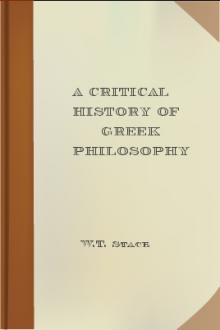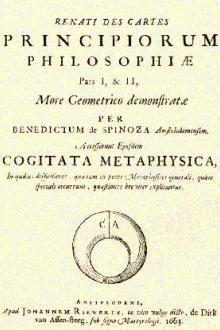A Critical History of Greek Philosophy by W. T. Stace (the false prince series .txt) 📕

- Author: W. T. Stace
- Performer: -
Book online «A Critical History of Greek Philosophy by W. T. Stace (the false prince series .txt) 📕». Author W. T. Stace
How are we to reconcile these two conflicting views of Parmenides? I think the truth is that these two contradictories lie side by side in Parmenides unreconciled, and still mutually contradicting each other. Parmenides himself did not see the contradiction. If we emphasize the one side, then Parmenides was a materialist. If we emphasize the other side, then he is to be interpreted as an idealist. In point of fact, in the history of Greek philosophy, both these sides of Parmenides were successively emphasized. He became the father both of materialism and of idealism. His immediate successors, Empedocles and Democritus, seized upon the materialistic aspect of his thought, and developed it. The essential thought of Parmenides was that Being cannot arise from not-being, and that Being neither {50} arises nor passes away. If we apply this idea to matter we get what in modern times is called the doctrine of the "indestructibility of matter." Matter has no beginning and no end. The apparent arising and passing away of things is simply the aggregation and separation of particles of matter which, in themselves, are indestructible. This is precisely the position of Democritus. And his doctrine, therefore, is a materialistic rendering of the main thought of Parmenides that Being cannot arise from not-being or pass into not-being.
It was not till the time of Plato that the idealistic aspect of the Parmenidean doctrine was developed. It was the genius of Plato which seized upon the germs of idealism in Parmenides and developed them. Plato was deeply influenced by Parmenides. His main doctrine was that the reality of the world is to be found in thought, in concepts, in what is called "the Idea." And he identified the Idea with the Being of Parmenides.
But still, it may be asked, which is the true view of Parmenides? Which is the historical Parmenides? Was not Plato in interpreting him idealistically reading his own thought into Parmenides? Are not we, if we interpret him as an idealist, reading into him later ideas? In one sense this is perfectly true. It is clear from what Parmenides himself said that he regarded the ultimate reality of things as material. It would be a complete mistake to attribute to him a fully developed and consistent system of idealism. If you had told Parmenides that he was an idealist, he would not have understood you. The distinction between materialism and idealism was not then developed. If you had told him, moreover, that Being is a concept, he would not have understood {51} you, because the theory of concepts was not developed until the time of Socrates and Plato. Now it is the function of historical criticism to insist upon this, to see that later thought is not attributed to Parmenides. But if this is the function of historical scholarship, it is equally the function of philosophic insight to seize upon the germs of a higher thought amid the confused thinking of Parmenides, to see what he was groping for, to see clearly what he saw only vaguely and dimly, to make explicit what in him was merely implicit, to exhibit the true inwardness of his teaching, to separate what is valuable and essential in it from what is worthless and accidental. And I say that in this sense the true and essential meaning of Parmenides is his idealism. I said in the first chapter that philosophy is the movement from sensuous to non-sensuous thought. I said that it is only with the utmost difficulty that this movement occurs. And I said that even the greatest philosophers have sometimes failed herein. In Parmenides we have the first example of this. He began by propounding the truth that Being is the essential reality, and Being, as we saw, is a concept. But Parmenides was a pioneer. He trod upon unbroken ground. He had not behind him, as we have, a long line of idealistic thinkers to guide him. So he could not maintain this first non-sensuous thought. He could not resist the temptation to frame for himself a mental image, a picture, of Being. Now all mental images and pictures are framed out of materials supplied to us by the senses. Hence it comes about that Parmenides pictured Being as a globe-shaped something occupying space. But this is not the truth of Parmenides. This is simply his failure to realise {52} and understand his own principle, and to think his own thought. It is true that his immediate successors, Empedocles and Democritus, seized upon this, and built their philosophies upon it. But in doing so they were building upon the darkness of Parmenides, upon his dimness of vision, upon his inability to grapple with his own idea. It was Plato who built upon the light of Parmenides.
Zeno
The third and last important thinker of the Eleatic School is Zeno who, like Parmenides, was a man of Elea. His birth is placed about 489 B.C. He composed a prose treatise in which he developed his philosophy. Zeno's contribution to Eleaticism is, in a sense, entirely negative. He did not add anything positive to the teachings of Parmenides. He supports Parmenides in the doctrine of Being. But it is not the conclusions of Zeno that are novel, it is rather the reasons which he gave for them. In attempting to support the Parmenidean doctrine from a new point of view he developed certain ideas about the ultimate character of space and time which have since been of the utmost importance in philosophy. Parmenides had taught that the world of sense is illusory and false. The essentials of that world are two-- multiplicity and change. True Being is absolutely one; there is in it no plurality or multiplicity. Being, moreover, is absolutely static and unchangeable. There is in it no motion. Multiplicity and motion are the two characteristics of the false world of sense. Against multiplicity and motion, therefore, Zeno directed his {53} arguments, and attempted indirectly to support the conclusions of Parmenides by showing that multiplicity and motion are impossible. He attempted to force multiplicity and motion to refute themselves by showing that, if we assume them as real, contradictory propositions follow from that assumption. Two propositions which contradict each other cannot both be true. Therefore the assumptions from which both follow, namely, multiplicity and motion, cannot be real things.
Zeno's arguments against multiplicity.
(1) If the many is, it must be both infinitely small and infinitely large. The many must be infinitely small. For it is composed of units. This is what we mean by saying that it is many. It is many parts or units. These units must be indivisible. For if they are further divisible, then they are not units. Since they are indivisible they can have no magnitude, for that which has magnitude is divisible. The many, therefore, is composed of units which have no magnitude. But if none of the parts of the many have magnitude, the many as a whole has none. Therefore, the many is infinitely small. But the many must also be infinitely large. For the many has magnitude, and as such, is divisible into parts. These parts still have magnitude, and are therefore further divisible. However far we proceed with the division the parts still have magnitude and are still divisible. Hence the many is divisible ad infinitum. It must therefore be composed of an infinite number of parts, each having magnitude. But the smallest magnitude, multiplied by infinity, becomes an infinite magnitude. Therefore the many is infinitely large. (2) The {54} many must be, in number, both limited and unlimited. It must be limited because it is just as many as it is, no more, no less. It is, therefore, a definite number. But a definite number is a finite or limited number. But the many must be also unlimited in number. For it is infinitely divisible, or composed of an infinite number of parts.
Zeno's arguments against motion.
(1) In order to travel a distance, a body must first travel half the distance. There remains half left for it still to travel. It must then travel half the remaining distance. There is still a remainder. This progress proceeds infinitely, but there is always a remainder untravelled. Therefore, it is impossible for a body to travel from one point to another. It can never arrive. (2) Achilles and the tortoise run a race. If the tortoise is given a start, Achilles can never catch it up. For, in the first place, he must run to the point from which the tortoise started. When he gets there, the tortoise will have gone to a point further on. Achilles must then run to that point, and finds then that the tortoise has reached a third point. This will go on for ever, the distance between them continually diminishing, but never being wholly wiped out. Achilles will never catch up the tortoise. (3) This is the story of the flying arrow. An object cannot be in two places at the same time. Therefore, at any particular moment in its flight the arrow is in one place and not in two. But to be in one place is to be at rest. Therefore in each and every moment of its flight it is at rest. It is thus at rest throughout. Motion is impossible.
{55}
This type of argument is, in modern times, called "antinomy." An antinomy is a proof that, since two contradictory propositions equally follow from a given assumption, that assumption must be false. Zeno is also called by Aristotle the inventor of dialectic. Dialectic originally meant simply discussion, but it has come to be a technical term in philosophy, and is used for that type of reasoning which seeks to develop the truth by making the false refute and contradict itself. The conception of dialectic is especially important in Zeno, Plato, Kant, and Hegel.
All the arguments which Zeno uses against multiplicity and motion are in reality merely variations of one argument. That argument is as follows. It applies equally to space, to time, or to anything which can be quantitatively measured. For simplicity we will consider it only in its spatial significance. Any quantity of space, say the space enclosed within a circle, must either be composed of ultimate indivisible units, or it must be divisible ad infinitum. If it is composed of indivisible units, these must have magnitude, and we are faced with the contradiction of a magnitude which cannot be divided. If it is divisible ad infinitum, we are faced with the contradiction of supposing that an infinite number of parts can be added up and make a finite sum-total. It is thus a great mistake to suppose that Zeno's stories of Achilles and the tortoise, and of the flying arrow, are merely childish puzzles. On the contrary, Zeno was the first, by means of these stories, to bring to light the essential contradictions which lie in our ideas of space and time, and thus to set an important problem for all subsequent philosophy.
{56}
All Zeno's arguments are based upon the one argument described above, which may be called the antinomy of infinite divisibility. For example, the story of the





Comments (0)